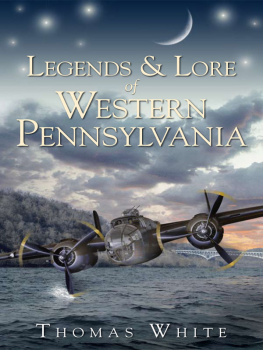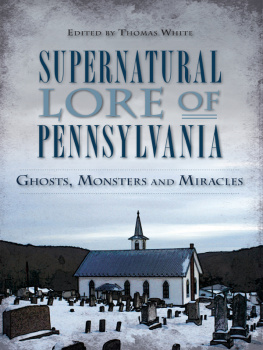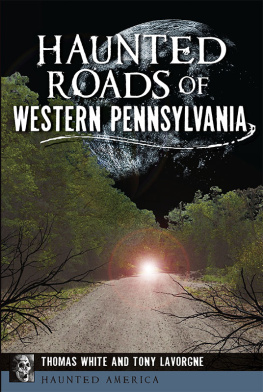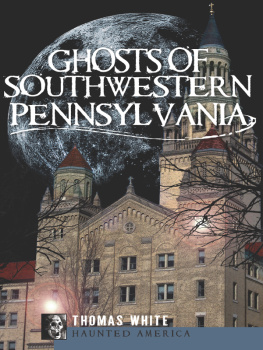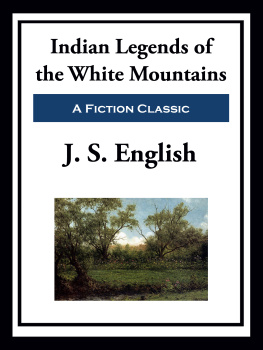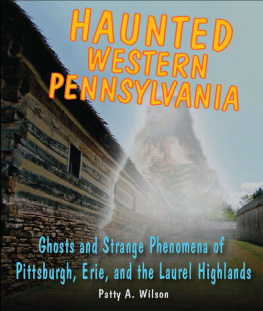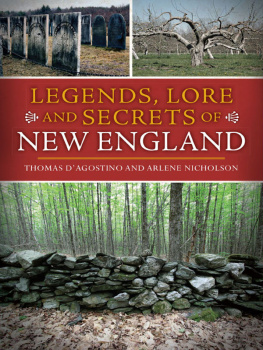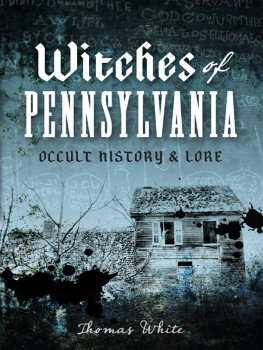

Published by The History Press
Charleston, SC 29403
www.historypress.net
Copyright 2009 by Thomas White
All rights reserved
Cover image: Courtesy of Filmet: A Graphics Solution Company.
First published 2009
Second printing 2010
Third printing 2011
Fourth printing 2012
e-book edition 2013
Manufactured in the United States
ISBN 978.1.62584.264.0
Library of Congress Cataloging-in-Publication Data
White, Thomas.
Legends and lore of western Pennsylvania / Thomas White.
p. cm.
Includes bibliographical references.
print edition ISBN 978-1-59629-731-9
1. Folklore--Pennsylvania. 2. Legends--Pennsylvania. 3. Tales--Pennsylvania. 4. Pennsylvania--Social life and customs--Anecdotes. 5. Pennsylvania--Biography--Anecdotes. 6. Pennsylvania--History, Local--Anecdotes. I. Title.
GR110.P4W47 2009 398.209748--dc22 2009019603
Notice: The information in this book is true and complete to the best of our knowledge. It is offered without guarantee on the part of the author or The History Press. The author and The History Press disclaim all liability in connection with the use of this book.
All rights reserved. No part of this book may be reproduced or transmitted in any form whatsoever without prior written permission from the publisher except in the case of brief quotations embodied in critical articles and reviews.
For Mom and Dad
CONTENTS
ACKNOWLEDGEMENTS
Any book on folklore, by nature, relies on the contributions of many people. That is certainly the case with this volume. On a personal level, I would like to thank my parents, Tom and Jean, for all their years of sacrifice that made everything I have done possible. I also want to thank my wife, Justina, and my children, Tommy and Marisa, for their support in finishing this project, and my brother Ed for his advice.
Doug MacGregor and Steve Doell began gathering folklore with me years ago at the Heinz History Center, and their work provided vital contributions to this book. Emily Jack put in many volunteer hours conducting interviews about urban legends, and I relied heavily on her research. The staff of the Library and Archives of the Heinz History Center, especially Bob Stakeley, Art Louderback and David Grinnell, was extremely helpful and accommodating during my research, as was Courtney Keel in the Museum Division. I also need to thank Paul Demilio, Aaron Carson, Megan Defries and Elizabeth Williams for proofreading and their constructive comments, as well as Michael Hassett for gathering information on my behalf in New Castle.
Many other people made important contributions to this book in one form or another, including Jim Matuga, Bob Bauder, Kerry Crawford, Dr. Joseph Rishel, Anne Marie Grzybek, Stephanie Busi and Bob Shema and the rest of the B-25 Recovery Group. And special thanks to Dan Simkins, Brian Hallam, Vince Grubb, Ken Whiteleather, Kurt Wilson and especially Tony Lavorgne, all of whom have accompanied me at various times while I have been out chasing legends.
INTRODUCTION
Western Pennsylvania is an area rich in folklore and legends. This region was forged by blood and steel and by innovation and faith. It has been many thingsa battleground, a gateway to the frontier, a workshop for the world and a center of religion and education. Tradition thrives here. Families took root in western Pennsylvania and stayed for generations. They formed stable, tightknit communities in the cities, along the rivers and in the hinterlands. That stability allowed the population to maintain connections to the past, and regional folklore flourished. Traditional beliefs, customs and stories were handed down orally at first and later in printed forms. Legends that might have been lost in an area with a more transient population survived here.
While growing up in the suburbs of Pittsburgh, I heard many of the legends related in this book, as well as many that I have not included. Before the age of eight, I was already familiar with the Lost Bomber of the Monongahela, the ghosts of the Conneaut Hotel and others. By the time I was in high school, I had heard all about the Kecksburg incident and the cults that practiced their dark arts on Blue Mist Road. Somewhere in the back of my mind, I filed all of those entertaining and mysterious stories away for future reference. In college, I went into the field of history (public history specifically), and archives and museum work became my career. Folklore has a strange relationship with traditional academic history. Despite the fact that they are intertwined on a local level, in academia the two fields usually run parallel and rarely intersect. One place in which they do cross is in the area of public history, a field that serves as a bridge between the academic and the popular. Working in the field of public history allowed me the opportunity to gather and examine regional folklore. The result is the volume that you are reading now.
The most difficult part of writing this book was deciding what stories to include. Over the past ten years, I have gathered hundreds of pieces of regional folklore. Whenever I thought I had covered everything, I always found more. The legends recounted in this book represent only a small sampling of that folklore. They are a mixture of some of the more prominent legends, like the Lost Bomber and Braddocks gold, and some of my personal favorites, like Blue Mist Road and Old Tom Fossit. I attempted to include stories from as many counties in western Pennsylvania as possible, but I could not cover them all. For the stories that are included, I have attempted to provide as much cultural and historic context as possible within the constraints of this book.
While they are entertaining, these legends and folk tales can tell us a great deal about the people from whom they emerge. In 1968, Richard Dorson, former director of the Folklore Institute at Indiana University, wrote, Folklore is the culture of the people. It is the hidden submerged culture lying in the shadow of the official civilization about which historians write. Folklore and legends can convey fears, provide warnings and commemorate people and events, both good and bad. They can show what communities and average people hold as important, as well as what leaves a permanent impact on them. Western Pennsylvanias folklore has all of these attributes to varying degrees. I have attempted to strike a balance between telling the stories and a small amount of interpretation when possible. I am not sure if I have always been successful in this approach. Either way, I hope that you find these mysterious legends as entertaining as I have.
PART I
LEGENDS OF THE FRENCH AND INDIAN WAR
Founding History, Founding Myth
The French and Indian War (175463) was an intense and pivotal conflict in the final decades of British colonial rule in America. The British, the French and the Indians engaged in warfare all along the frontier and backcountry, struggling for control over Americas interior. The fighting spread to Europe and to other colonies around the world, becoming the first real world war. After nine years of conflict in the Americas and seven in Europe, the British emerged victorious, claiming the continent of North America as their prize and securing their place as the superpower of Europe. But the war also sowed the seeds of dissent among American colonists. Their resentment of British policies after the war ultimately led to the American Revolution.
Next page
